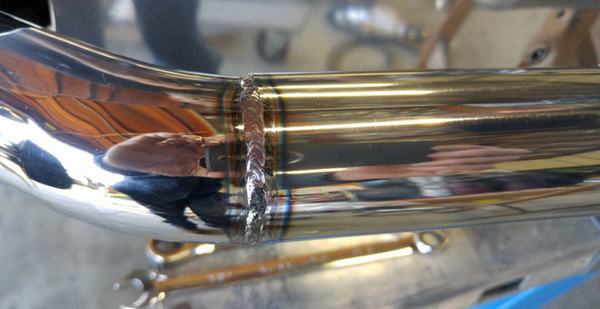
Welding polished stainless steel often causes a particular type of “rainbow” discoloration. Professor Hammer will tell you how to remove this coloring.

Welding polished stainless steel often causes a particular type of “rainbow” discoloration. Professor Hammer will tell you how to remove this coloring.
Q
I am making a stainless exhaust system and I’m polishing the tubing. I am leaving the welds as-is and do not plan to grind them down. I find that the weld polishes up nicely, but the edges of the heat-affected zone have a nice rainbow line that is resistant to polishing out. I have attached a picture of the weld. While the colors are pretty, I would rather have them polished away.
Do you know of a technique for cleaning this up? Maybe something about my welding is causing this? Thanks for your help.
A
The “rainbow” area next to the weld is just a few atoms thick, and if you use a more aggressive polishing compound(click for Guangdong Redsunstar's quality polishing compound), you’ll quickly get down to clean stainless. It looks like you are using a soft, cotton, polishing wheel and some fine compound. You’ll probably have to use a sisal wheel, and a more aggressive compound. After you have taken the color off, you can go back to the softer wheel and finer compound and the brilliant polished stainless will look like chrome.
Q
I need some guidance regarding metal preparation prior to assembly of welded body panels. I have read all the ads for POR-15 and a gazillion other rust encapsulators and inhibitors. But with only one project to limit testing and a nonexistent budget (my kids have to go to college), I would like to know what the pros do so that I can move on with the project.
The question is: What is the best method for preparing metal that will never see the light of day, but might be vulnerable to rusting due to condensation?
On another project, I can see that after 40-plus years the unprotected metal on a welded-in repair has developed surface rust in most areas, and a few areas show substantial rusting.
I have used 5717S metal conditioner from Axalta on other repairs, followed by an epoxy primer. I’m not sure if both are required. The problem is that the primer needs to be removed for welding, so I followed up with a weld-through primer in these areas. This is very time-consuming, and I’m not sure if it is the proper way to handle the issue.
How do you guys prevent rust in these areas, or do you even worry about it?
A
I think you’ll find many different opinions about the “right” way to protect metal for welded repairs. Without any protection, a steel panel will last a few years, but it doesn’t take much moisture or dampness to cause rusting, and once rust has started, it can slowly eat all the way through sheetmetal panels.
Epoxy primer is the “gold standard” for protecting steel panels over the long haul. Certainly the metal needs to be clean and free of any rust or corrosion before applying the primer. I don’t know what benefits the 5717S conditioner may offer. It certainly can’t hurt, but I’ve never used it.
As you say, if you’re welding parts coated with epoxy primer, you’ll have to strip the primer off at the weld areas. Spraying some weld-through primer on these areas before welding can help if you are using the MIG process, but you’ll find that TIG welding doesn’t work very well over ANY primer. If you can get some epoxy primer onto the welded areas after the welding is finished that will probably offer the best long-term solution. Sometimes, you can reach areas with a brush that may be inaccessible with a paint gun.
I prefer to use butt welds whenever I can. If you have any lap joints, it’s very difficult to get primer into the overlapped area, and this has been known to cause a rust-through within just a few years.